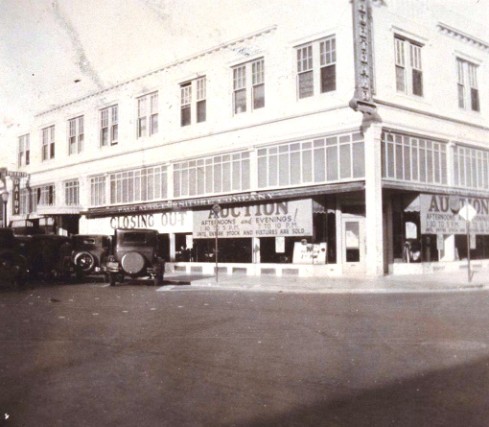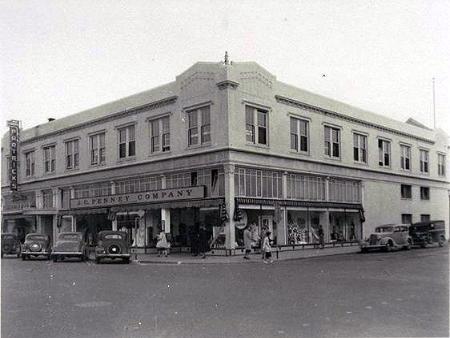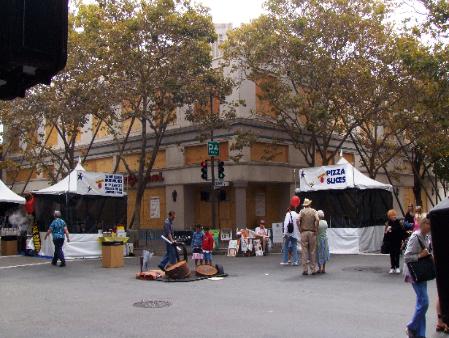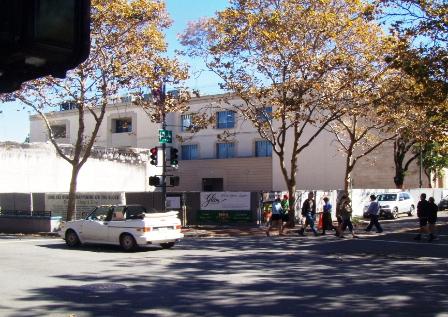300 University Avenue: One Building's Story
Note: This story was written in 2008...
It was reported recently that the building standing at 300 University Avenue --- which until last month housed a Walgreens and a Subway franchise --- is going to have to come down. As anyone who has been Downtown lately knows, the building was the victim of a fire (determined to be arson) on the evening of July 1st. City officials have since declared the building “dangerous and a public nuisance" and have ordered that it be demolished beginning August 27th.
Of course, there are many people who start rolling their eyes when architects, historians or preservationists begin to wax sentimental about manmade structures --- “It’s just a building, you know?” So the fact that a fairly indistinguished corner structure containing a couple of reproducible national chain stores will soon be
history ---well, no big deal.
But let’s look at the story of this building. Sure, it’s not a structure that really stands out. It certainly does nothave the age and history of the Juana Briones House or the Greco-Roman gallantry of the John Squiare House ---both Palo Alto structures which have been the subject of preservationist efforts. Many Palo Altans have probably walked into the 300 University building scores of times to pick up a prescription or a 6-inch on wheat without ever once looking up.
But age alone should grant the building some recognition. The 107 year-old building first opened for business when William McKinley was in the White House. And there it has stood through the years as Palo Alto grew up around it. It was there in 1918 when Camp Fremont soldiers marched past on their way to the battlefields of World War I. It was there in 1942 when another generation of Palo Altan men went off to fight in another world war. It was there in the early 1970s when Joan Baez led a march of students against Vietnam down University Avenue. And it was even there last year for the 85th annual May Fete parade, just as it had been for the previous 84. Combing through old photos of Palo Alto, the building stands resolutely through the years, always ready for business at the corner of University Avenue and Bryant Street.
And the structure also tells the story of those businesses which have occupied it. Each business has been iconic of the era in which it succeeded. In its early days, the 300 University building was home to the highly successful Palo Alto Furniture Company, the kind of homegrown business that once had a far easier road to success in America. Today a store like Palo Alto Furniture would have to play David to Goliaths like Ikea, Pottery Barn and Jennifer Convertibles, just to name a few. Indeed, these are much tougher days for Mom & Pop.
300 University’s second life was as a JC Penney’s ---“The Home of Values”--- one of the early pioneers of the national chain store. Back before Walmart, Target and Home Depot rose as the kings of suburban sprawl, their trail was blazed by early chains such as F.W. Woolworth’s, J.C. Penney’s and other nationally-based, but more locally embedded department stores. Founded in 1902 in Kemmerer, Wyoming, Penney’s grew at a startling rate of speed. They had 500 stores in 1922, and had doubled that number just six years later.
Palo Alto’s J.C. Penney’s opened in 1924 at 300 University and was run for two decades by Merrill Vanderpool,the kind of locally based store manager who was very much a part of the community --- he was elected to Palo Alto’s school board and Community Center commission, as well as serving as president of the Rotary Club and participated in the operation of the YMCA and American Legion. J.C. Penney’s on University had similar local connections --- it was part of the neighborhood, not just a big box plunked down in an enormous parking lot.
In 1973, 300 University had a third go-around as a Walgreens and later a Subway opened on its eastern side. These two national chains are typical of the explosion of chain stores in the last two decades of the 20th Century. Today more than just department stores are dominated by national franchises. Take sandwich shops... Subway, Quizno's and Togo’s shops have run amok in Palo Alto, bullying local favorites like the Village Cheese House. Similarly, Walgreens and Long's drug stores now offer discounts that tiny Disco Rex Pharmacy on University or Maximart Pharmacy on Cambridge Avenue struggle to match. And the trend has carried over to most other industries as well. Local Palo Alto businesses have to compete with
national chains in virtually every field --- from bagel shops to book stores, banks to ice cream parlors. And Walgreens has never added the same local flavor to the city as J.C. Penney’s or the Palo Alto Furniture Company.
Over the years, 300 University Avenue has also had smaller shops on the ground floor or in offices upstairs. Patrick’s Candy, the Golden State Creamery, the San Jose Mercury News, University Realty and the offices of celebrated Palo Alto architect Birge Clark have all been in the building over the years.
Indeed, a lot has happened since 1900 in this one downtown building. 107 years of customers coming and going, registers chiming, greetings exchanged, money changing hands. For a city to be a hometown --- not just part of your mailing address --- it’s important to have some buildings that have been there awhile, that have been around to see the city grow. And while there may not be anything so special about 300 University, when the wrecking ball brings it down, I’ll be sorry to see it go. []
Our Reader's Memories:
I will miss this building too.
I have been using it for almost 50 years.I think that some people on this forum may have been quick to write their opinions before knowing the history. They may be happy to see the building demolished, when (in reality) they
may be happier to see the old Walgreens go, the Sandwich Shop, and the homeless sitting outside. I will miss the building for what it stood for through the years. With it, I feel a bit of myself will be torn down too.
The building was not maintained in a historical way. The existing shops were out of place. I just returned from the East Coast, where I saw many cities make sure that the new businesses fit into the historical structures so well that at times I had a difficulty locating a Rite Aid because I drove by it several times, thinking it was just another one of the historical buildings on the main street. Garish new buildings were not allowed in these busy little towns. Many towns were able to preserve their original quaint character, yet still have the modern stores
within the town. I hope that the architect for the new building has something like that in mind.
Maybe they can plan to design a new building similar to one which was destroyed, and reference your historical photos and data in the planning. Thanks again for the great report!
-Long Time Resident
I was the manager of that Walgreens store from 1989 until 1994.I arrived at that store about a month before the Loma Prieta earthquake. In that downtown
Palo Alto must be built on bedrock, the only damage was a crack in a wall (in addition to almost EVERTHING falling off the shelves).
I was just about to leave and grab a seat at a bar across the street to watch the World Series when the earth moved.
Unbeknown to me, PGE willingly knocked out the power to almost all of Palo Alto .... but in that Walgreens was on the same circuit as the Police Station, our power stayed on ... and Walgreen was the ONLY business in downtown that re-opened. Business was like the day before Christmas and everything was 1/2 off ... a madhouse!
That building had a Elevator that was like a test model elevator. It was about 4' x 4', had an iron gate and shook like you wondered if you were going to get out alive.
It was a great old building.
-Joe
"My mom worked there in the 1960's. I always wondered if they kept that funny elevator! It went up to the offices and employees' lunchroom.
I miss that old place, and the friendly downtown of back then."
-T
Send Us Your Memory!


The 300 University Building when the J.C. Penney Company occupied the address. (PAHA)

After the fire in 2007.

After the 300 University building was demolished.

During the fire at 300 University. (PA Weekly)

The new building at 300 University Avenue.